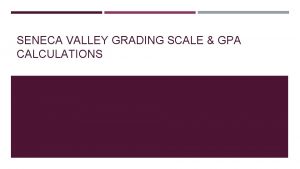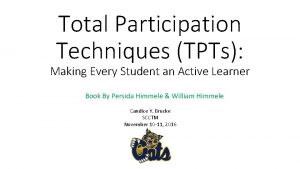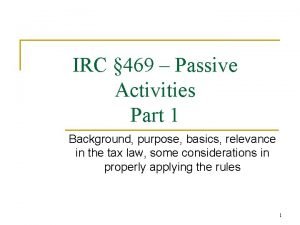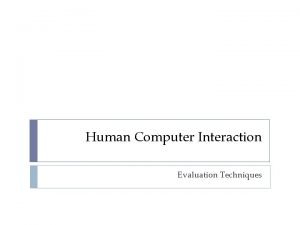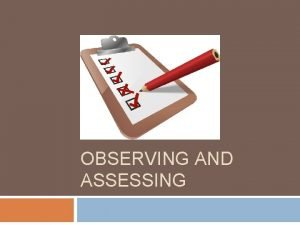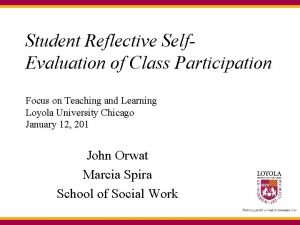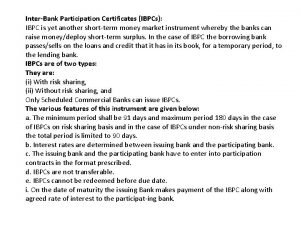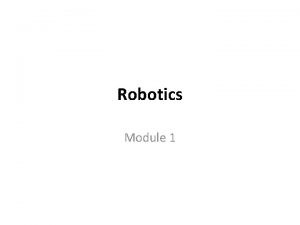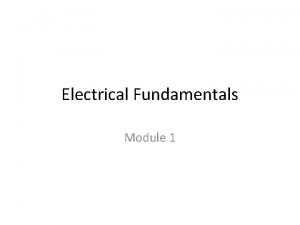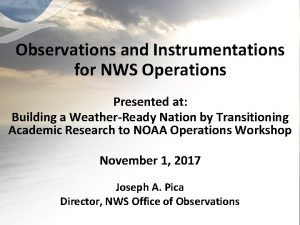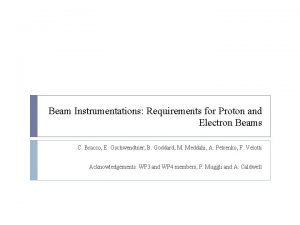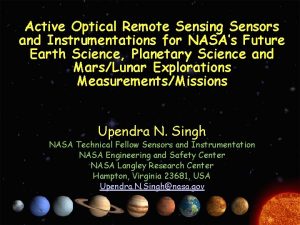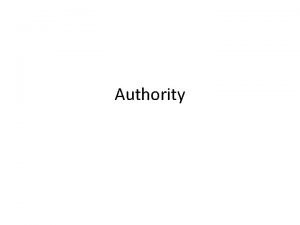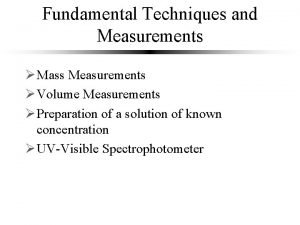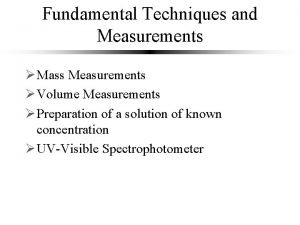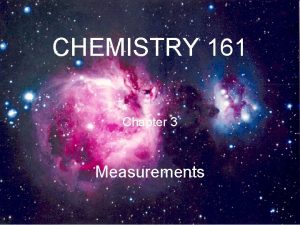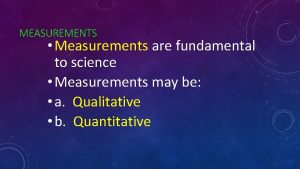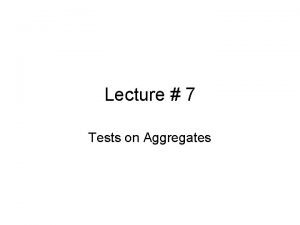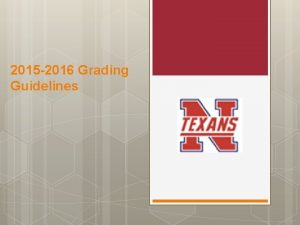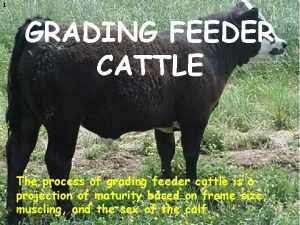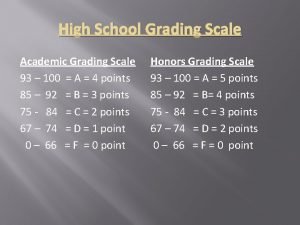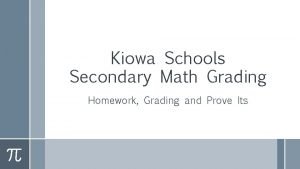Measurements Instrumentations Module 1 Grading policy Participation 10





























































- Slides: 61

Measurements & Instrumentations Module 1

Grading policy • Participation 10 marks – Preparation, Promptness, Level of Engagement, Behavior • HWs • Quizzes • Practical 10 marks 30 marks – Lab activities and Practical exam • IAT competency exams (practical and knowledge ) 40 marks

Preparation marks • Print the modules and cover it and bring it to every class with you • Calculator • Stationary • Lab coat

Participation Marks • Promptness: On time or Late • Level of Engagement • Behavior

Objectives • What is measurements • Measurements elements • Measurement methods / types

Introduction to measurements • All physical parameters are measurable, and the first step in any engineering process is measurement. • Measurement of abstract quantities like intelligence. • If we cannot measure something, we can not control it. This ‘something’ is referred to as a ‘physical quantity’.

Measurements forms • • • Physical dimensions of an object Count of an object Temperature of an object Fluid pressure / flow rate / volume Electrical voltage / current / resistors Machine position / speed

What we are trying to measure ?

What is measurements ? • Measurement is the process of determining the magnitude of a physical quantity such as length or mass, relative to a standard unit of measurement, such as the meter. • It could be also defined as a comparison between a standard and a physical quantity to produce a numeric value Measurements Elements

Measuring Devices • The measuring devices could be sensors, transducers or instruments. • A ruler (length) • A thermometer (temperature) • A light dependent resistor (LDR) measures (light intensity)

Skill 1: Identify the measurement elements Physical quantity: Measuring device: Numeric value: : Standard unit:

Methods of measurement • The two basic methods of measurement are – Direct measurement – Indirect measurement.

Direct Measurement • In direct measurement, the physical quantity is compared directly with a standard.

Indirect Measurement • In an indirect type of measurement, the physical quantity measured is converted to an analog form that can be processed and presented. • For example, the mercury in the mercury thermometer expands and contracts based on the input temperature, which can be read on a calibrated glass tube. A bimetallic thermometer

Question Physical quantity: diameter of the ball Measuring device: Vanier caliper Numeric value: -----Standard unit: cm

Recap • Define measurements • Measurements elements • Measurement types / methods

Warm up • Give an example of an error that occur when you are taking a measurement.

Objectives • • Definition of the error Types of the errors Error analysis – mean & standard deviation Calibration

Definition of the error • Error = Instrument reading – true value • Error types – Systematic errors – Random errors

Systematic Errors • The zero error of the instrument • The shortcomings of the sensor • Improper reading of the instrument due to the improper position of the person’s head/eye (Parallax error) • The environmental effect Parallax error demonstration

Systematic Errors • Systematic errors can be corrected by calibration. • Systematic errors can be traced and reduced

Random errors • Measuring the same quantity using the same instrument and every time you get different reading • Example of random error is – measuring the mass of gold on an electronic scale several times, and obtaining readings that vary in a random fashion.

Random errors • The reasons for random errors are not known and therefore can not be avoided • They can be estimated and reduced by statistical operations

Skill 2: Identify the type of measurement Picture Measurement type Direct Measurements Indirect Measurements

Error analysis • Error analysis are done for the random error • Average / Mean • Standard Deviation

Error analysis • Measuring the same input variable a number of times, keeping all other factors affecting the measurement the same, the measured value would differ in a random way. • The readings normally follow a particular distribution and the random error may be reduced by taking the average or mean. • The average/mean gives an estimate of the ‘true’ value

Error analysis

Example 1 • A mass of gold is measured 5 times find the mean Reading 1 Reading 2 Reading 3 Reading 4 Reading 5 10 g 10. 2 g 10. 3 g 10. 1 g 10. 4 g • Mean / Average =

Standard Deviation • The standard deviation, denoted by the letter ‘σ’ tells us about how much the individual readings deviate or differ from the average/mean of the set of readings.

Example 2 Reading (Reading – average) (Readings – average)2 16 19 18 16 17 19 20 15 17 13 -1 2 1 -1 0 2 3 -2 0 -4 1 1 0 4 9 4 0 16 40 Sum

Example 3 • A diameter of a wire is measured by a group of students with a micrometer, and the reading are shown below: • Assuming that only random errors are present, calculate the following: a) mean / Average b) Standard deviation Reading 2. 55 2. 65 2. 49 2. 69 (Reading – average) (Readings – average)2 -0. 016 0. 084 -0. 116 -0. 076 0. 124 0. 000256 0. 007056 0. 013456 0. 005776 0. 015376 0. 04192 Sum

Excersice

Recap • • • Error Systematic Error Random Error Mean Standard deviation

Warm Up • • Define measurements Measurements type Error Systematic Error Random Error Mean Standard deviation

Instrument Performance Evaluation • Any measuring instrument/device has a set of specifications that inform the user of its function. • These characteristics are described in the catalogue or datasheet provided by the manufacturer

Accuracy • Accuracy of an instrument is how close a measured value is to the true value.

Precision • The ability of an instrument to give the similar reading when the same physical quantity is measured more than once – The closer together a group of measurements are, the more precise the instrument. – A smaller standard deviation result indicates a more precise measurement.

Small STD Large STD

Precision of the instrument Measuring the same thing using the same instrument and every time a different reading is obtained Precision of the measurement Measuring the same thing using different instruments and every time a different reading is obtained

Precision Calculation STD = σ It will tell you which instrument is more precise Value max {(Avg – Min), (Max – Avg)}

What is the difference between precision and accuracy ? Accuracy Maximum deviation form the conventional true value =max {(CTV– Min), (Max – CTV)} Precision Maximum deviation form the average value =max {(Avg – Min), (Max – Avg)}

Precision of the instrument Student 1 5 mm Student 2 5. 2 mm Student 2 5. 1 mm Student 3 4. 5 mm Student 3 4. 9 mm Student 4 4. 7 mm Student 4 5 mm STD = σ = 0. 310913 STD = σ = 0. 08165 Which one is more precise ?

Precision of the instrument Trial 1 5 kΩ Trail 2 5. 5 kΩ Trail 3 4. 5 kΩ Trail 4 4. 3 kΩ Trial 1 5 kΩ Trail 2 5. 1 kΩ Trail 3 4. 9 kΩ Trail 4 4. 8 kΩ Trial 1 5 kΩ Trail 2 4 kΩ Trail 3 6 kΩ Trail 4 5 kΩ STD = 0. 537742 STD = 0. 129099 Which instrument is more precise ? STD = 0. 816497


Bias • The difference between the true value (TV) and average value (AV). • Ideally, the bias should be zero. • ���� = ���� − ����

Example • A mass of silver is measured four times and the values are shown below. If it the true value is 6 kg, find the bias Trail 1 Trail 2 Trail 3 Trail 4 6. 3 kg 6. 5 kg 6 kg

Range • The range of an instrument defines the minimum and maximum values that the instrument can measure. Min value = -40 o. F Max value = 120 o. F Range = 120 o. F – (-40 o. F) = 160 o. F

Min Value 0 Unit cm Max value 15 Unit cm Range =15 -0=15 Unit cm Min Value -40 Unit o. C Max value 50 Unit o. C Range 50 -(-40)=90 Unit o. C

Sensitivity • The sensitivity of a measuring instrument is its ability to detect small changes in the measured quantity. • Sensitivity = Change in output (y-axis)/Change in input (x-axis)

Linearity • Some measuring instruments/devices output a signal that is proportional to the input physical quantity. • These instruments are called linear devices. • Other instruments that don’t have a proportional relationship between the output signal and the input are non-linear devices.

Lab Activity 1

Resistor Color Code R = 25 * 10 1 Ω ± 5% = 25 * 10 Ω ± 12. 5 Ω Rmin = 237. 5 Ω Rmax = 262. 5 Ω

Resistor color code Colors: Red – Violet – green – Gold R = (27 x 105) ± 5% Ω Colors: Brown – Black – yellow – Silver R = (10 x 104 )± 10% Ω

Unit Conversion M k m µ 106 103 10 -6

Unit Conversion Examples 27. 0 x 105 10. 0 x 104 10. 0 x 10 -4 500. 0 x 10 -5 2. 7 x 106 = 2. 7 M 100 x 103 = 100 k 10 -3 = 1 m 5000 x 10 -6 =50µ

How to use DMM ?

How to use DMM ? Always must be connected

Part 1 color code Resistance value True Value DMM range Measured values Yellow – violet – brown - gold 470 Ω 2 kΩ 466 Brown – Black – Red Gold 1 kΩ 2 kΩ 1. 13 kΩ Orangeorange – red gold 3. 3 k Ω 20 kΩ 3. 31 kΩ Orange – white – orange - gold 39 k Ω 200 kΩ 38. 5 kΩ Brown – green - gold 1. 5 M Ω 2 MΩ 1. 51 MΩ % Error Within tolerance? Yes NO Yes Yes

Part 2 Resistor Reading Resistor True value: Brown – Black – Red - Gold DMM 1 1. 1 kΩ DMM 2 1. 2 kΩ DMM 3 1. 09 kΩ DMM 4 0. 99 kΩ DMM 5 0. 97 kΩ

Part 3 Reading Student 1 Student 2 Student 3 Student 4 Student 5 Mean Standard deviation Reading (diameter in mm) Reading – Mean (Reading – Mean )2

Recap • • • Define measurements Measurements form Measurements types Error Systematic Error / Random Error Mean Standard deviation Accuracy Precision Bias Range
 Partial participation adalah
Partial participation adalah Vipp plan
Vipp plan Module 7 weights and measures
Module 7 weights and measures Seneca college gpa scale
Seneca college gpa scale C device module module 1
C device module module 1 Albernian
Albernian Outstanding participation
Outstanding participation Vaict
Vaict Chapter 7 citizen participation in a democracy answers
Chapter 7 citizen participation in a democracy answers 5 levels of participation
5 levels of participation Oligarchy examples
Oligarchy examples Citizen participation in autocracy
Citizen participation in autocracy Empowerment and participation in organizational behavior
Empowerment and participation in organizational behavior Spreading excellence and widening participation
Spreading excellence and widening participation Widening participation and spreading excellence
Widening participation and spreading excellence Total participation techniques book
Total participation techniques book Participation constraints in dbms
Participation constraints in dbms Consumer participation
Consumer participation Leader participation model
Leader participation model Hud 2530 form
Hud 2530 form Nfhs illegal substitution football
Nfhs illegal substitution football Guided participation vygotsky
Guided participation vygotsky Citizen participation in oligarchy
Citizen participation in oligarchy Participation through language
Participation through language Lester milbrath classification of political participation
Lester milbrath classification of political participation Sports
Sports Thank you for your attention and participation
Thank you for your attention and participation Arnsteins ladder
Arnsteins ladder High participation
High participation Active participation strategies
Active participation strategies Participation crisis
Participation crisis Example of guided participation
Example of guided participation Section 469 material participation
Section 469 material participation Local provider participation fund
Local provider participation fund Roger hart ladder of participation
Roger hart ladder of participation Sisters participation in the gathering of israel
Sisters participation in the gathering of israel Active community participation definition
Active community participation definition Total participation techniques
Total participation techniques How to compute participation rate in school
How to compute participation rate in school Evaluation through user participation in hci
Evaluation through user participation in hci Disadvantages of participation charts
Disadvantages of participation charts Class participation self-evaluation essay
Class participation self-evaluation essay Integration continuum for sport participation
Integration continuum for sport participation Ohio home care waiver conditions of participation
Ohio home care waiver conditions of participation Settings
Settings Continuum of participation
Continuum of participation Motivation for recreational participation
Motivation for recreational participation Child participation assessment tool
Child participation assessment tool Technology of participation
Technology of participation Promote active participation
Promote active participation Kuwait turkish properties
Kuwait turkish properties Financial literacy and stock market participation
Financial literacy and stock market participation Forced participation
Forced participation What is ibpc
What is ibpc Joint management council
Joint management council Participation banks association of turkey
Participation banks association of turkey Pleasure and participation sports
Pleasure and participation sports Thank u for attention
Thank u for attention Workers participation in management
Workers participation in management Accounting for loan participations
Accounting for loan participations Autocracy vs oligarchy
Autocracy vs oligarchy Different kinds of choral speaking
Different kinds of choral speaking



